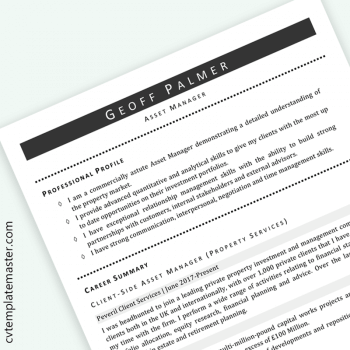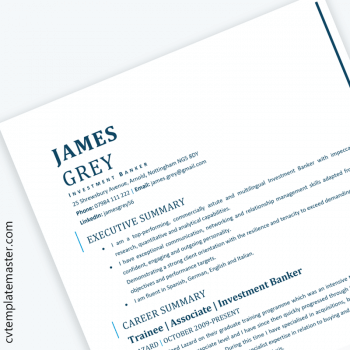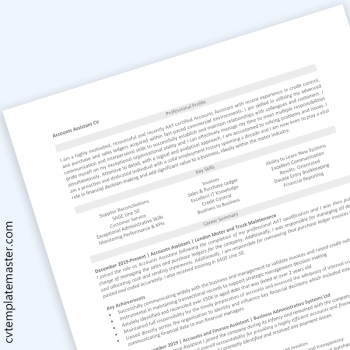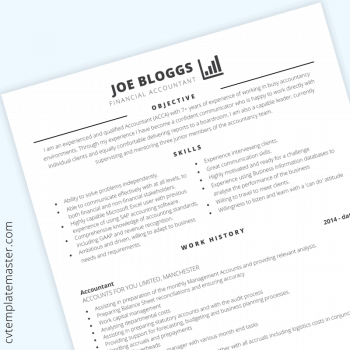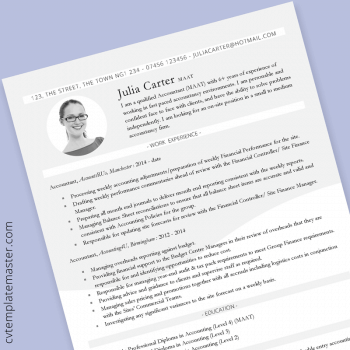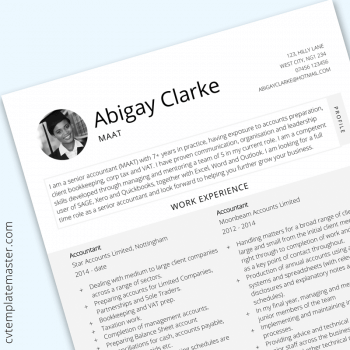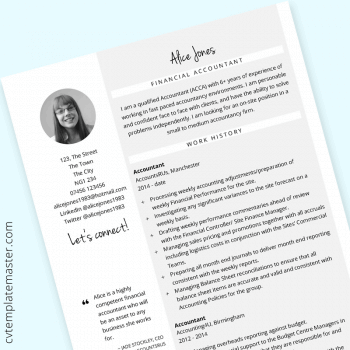How to write an accountant CV
There are some important points to note when writing a CV for an accountancy or finance role. Here, we look at how to write each section of your CV, step-by-step.
1) Name
You should include your first and last name – title (Mr, Mrs etc) is not necessary and should not be used.
Most accountants will also have letters after their name which should be included (e.g. ICAEW, ACA, FCA, ACCA, MAAT, FMAAT etc), either immediately after your name or underneath. This helps employers quickly see that you have the appropriate qualification that they are looking for.
2) Contact information
Contact information is usually included just underneath your name. Typically the following details are included:
- Postal address
- Email address
- Phone number(s)
In addition, as a professional, it’s recommended to create both LinkedIn and Twitter profiles and include details of these on your CV. LinkedIn offers a great opportunity to expand out the information contained on your CV and obtain endorsements from credible contacts. Twitter is a great opportunity to demonstrate to prospective employers that you’re immersed in the accounting and finance industry, and aware of current issues/developments.
Read here about how to build a killer LinkedIn profile to complement your CV.
Many candidates will include additional information in their contact section which is not only unnecessary but can also harm their chances of an interview. Anything that relates to a protected characteristic will be unnecessary for the great majority of jobs.
Read more about protected characteristics in our article, ‘Was I discriminated against during the recruitment process?‘
You should never include unnecessary personal information on your CV.
3) Personal statement
Faced with a very large pile of CVs, employers have very little time to spend on each application and will quickly skim through for suitable candidates. It’s therefore essential that you write a compelling personal statement to tell the employer very quickly why you’re suitable for the accountancy or finance role you’re applying to.
A personal statement should be 3 – 4 lines and should confirm that you have the necessary qualifications, skills and experience detailed in the job advert. Here’s a snippet from an example accountancy job advert:
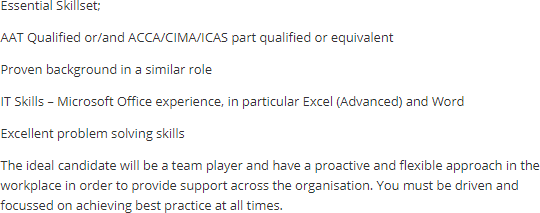
The employer here is concerned about:
- Specific accountant qualifications (AAT, ACCA etc)
- Past experience in similar role
- IT skills – esp. Excel (advanced) and Word
- Problem solving skills
- Team work
- Proactive, flexible
- Driven and focused on achieving best practice
Firstly, here is a BAD example of a personal statement for this accounting role:
I am a qualified accountant with 3 years’ of work experience. I have excellent IT skills in Excel and Word, and well developed problem solving skills. I can work well on my own or as part of a team, taking a proactive and flexible approach to my work. I am driven and focused on achieving best practice.
The second example simply copies the words from the job advert. It doesn’t tell the employer anything and will most likely result in the application being rejected.
Now, consider this GOOD example of a personal statement for this accounting role:
I am an AAT qualified accountant (soon to be MAAT) with 3 years’ experience as an Assistant Management Accountant. I currently work in a team of 3 with about 50% of my clients having more complex financial circumstances. I take a proactive approach to identifying issues and saving my clients money – consequently, I have attracted over £200k of revenue to the firm in the past year via word-of-mouth recommendations. In addition, I write/deliver firmwide training on updates to best practice. I am an expert user of Excel (10 years+) and a competent user of Word.
In this example, the candidate SHOWS rather than TELLS the employer that they meet the requirements. For example:
- Rather than saying ‘I have problem solving skills’, they explain that they work on complex cases (which would require those skills).
- Rather than saying ‘I am proactive’, they prove that they have been proactive resulting in substantial growth for the firm.
If the job profile is a little thin on the ground when it comes to specifics, take a look at an example profile for the respective role on Prospects.ac.uk here. This will tell you the type of qualifications, skills and experience that a typical employer is interested in, which you can use in your personal statement.
4) Work experience / employment history
This section should be presented in reverse chronological order (most recent role first). Offer more detail to roles that are closest to the one you’re applying for – on other roles, pick out any transferable skills.
Write your employment history with the advert in mind, focusing on how you have demonstrated the employer’s requirements in each role.
Try to avoid employment gaps – if you’ve had completely irrelevant jobs, include the job title, employer and dates without any further detail. However, do think carefully about whether there were any aspects of the role where you used skills relevant to your target position.
5) Education
This section is usually presented with your highest qualification first, down the lowest. Professional qualifications like ICAEW come after your academic qualifications (undergraduate degree / masters).
Of course, these rules work fine if you’ve studied everything in a logical order – however, what if you qualified in one field (for example, gaining your undergraduate degree and masters in Biology) and then went into accountancy later? The answer is, highlight the qualifications the employer has requested FIRST and then detail the other qualifications underneath.
In all cases make sure you use the keywords and phrases the employer has used in their advert. For example, if the employer has requested ‘ICAEW’, don’t simply write ‘Chartered Accountant’. Instead, write ‘Chartered Accountant (ICAEW)’. The reason for this is that the employer may be using ATS software to screen the applications initially and if one of the screening criteria is ICAEW, you won’t want to miss this off!
Read our article, ‘What is an ATS compliant CV or Résumé?‘ for more information on ATS.
6) Memberships
Memberships is an optional section but for experienced accountants, it is an opportunity to show that you’re involved in the industry and interested in professional standards. They might be different from your awarding body – for example, BAFA (British Accounting and Finance Association), represents those interested in teaching and research in accounting and finance; whilst the SPA (Society of Professional Accountants) represents qualified accountants in small practices.
7) Publications
If you’ve been practising for a while, you may have contributed to accounting publications, either online or offline. Detailing these on your CV demonstrates knowledge and shows your passion for the industry. If you’ve offered a quote, co-authored a piece or provided consultancy, you can mention your contribution here too.
8) Interests
Many CV writers will tell you that the hobbies and interests section is the least important part of your CV – but we disagree. Firstly, this section can be used to further demonstrate soft skills (such as team work, dedication and leadership). Secondly, this section can implicitly tell the employer that you’re a healthy person that is likely to show up for work (through interests in fitness, sports etc).
9) References
Two references are previously required. The first is typically your current employer and the second should be a previous employer, educator or person of professional standing (not a relative).
Example accountant CV template:
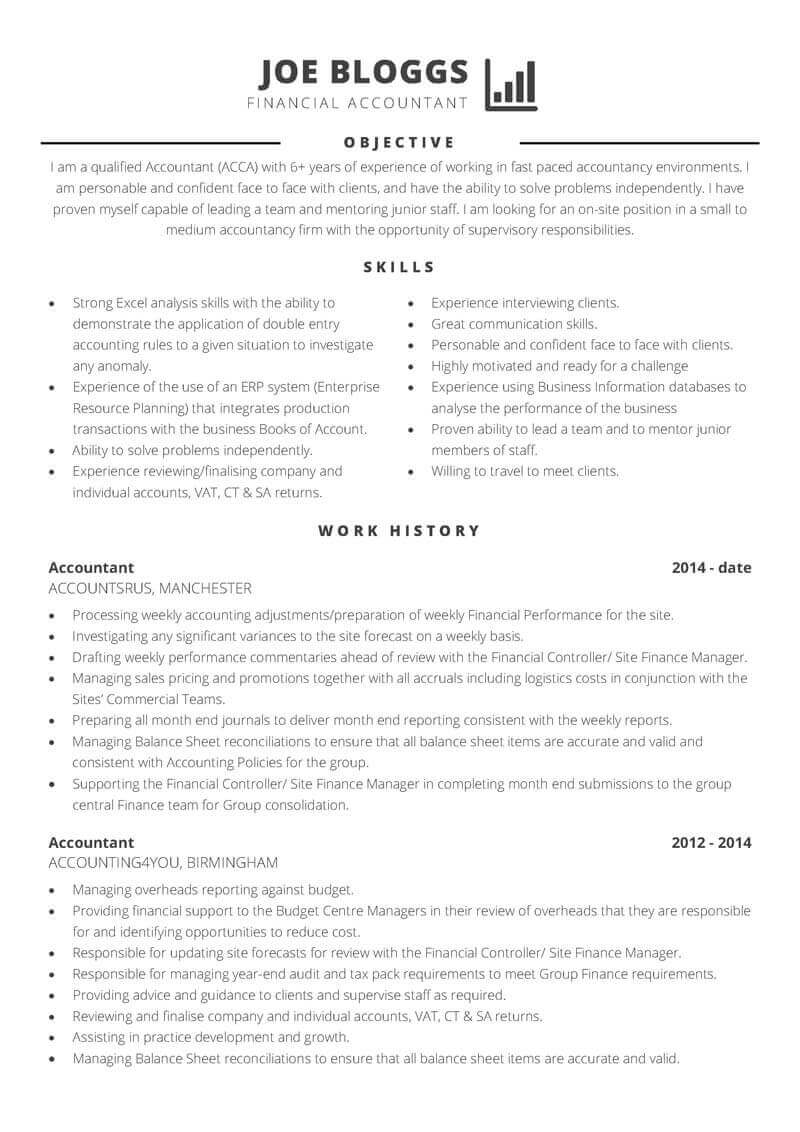
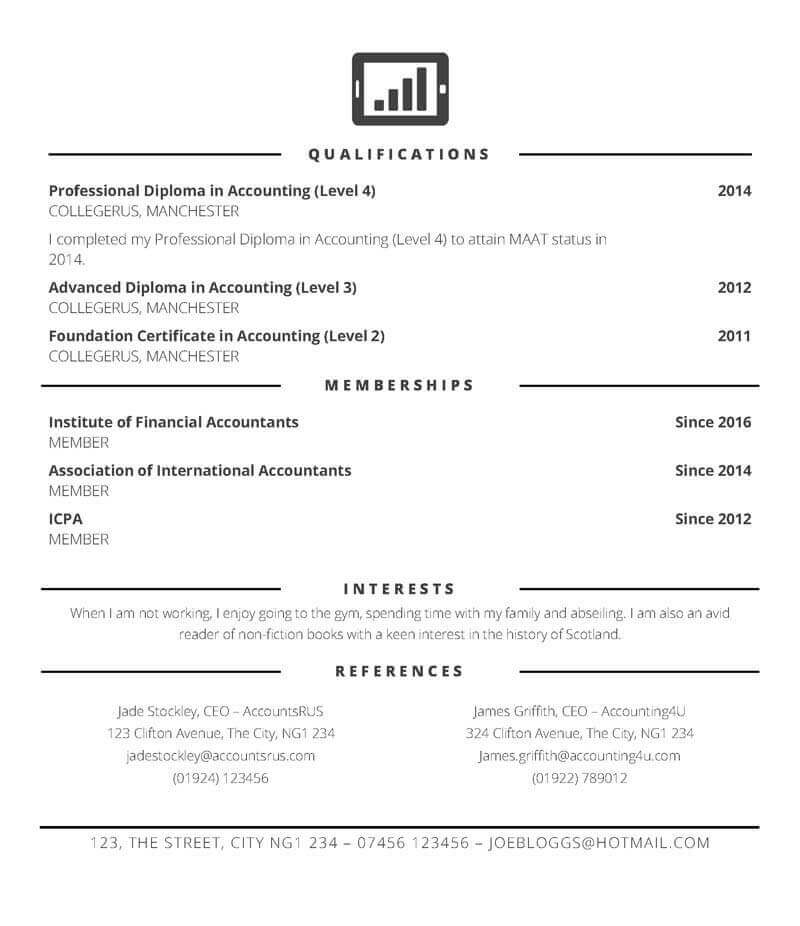
The above template can be downloaded here – alternatively, there are lots more accountancy and finance themed CV templates above.
